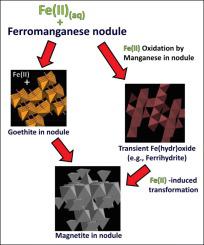当前位置:
X-MOL 学术
›
Chem. Geol.
›
论文详情
Our official English website, www.x-mol.net, welcomes your
feedback! (Note: you will need to create a separate account there.)
Fe(II)-induced transformation of iron minerals in soil ferromanganese nodules
Chemical Geology ( IF 3.6 ) Pub Date : 2021-01-01 , DOI: 10.1016/j.chemgeo.2020.119901 Chengshuai Liu , Michael S. Massey , Drew E. Latta , Yafei Xia , Fangbai Li , Ting Gao , Jian Hua
Chemical Geology ( IF 3.6 ) Pub Date : 2021-01-01 , DOI: 10.1016/j.chemgeo.2020.119901 Chengshuai Liu , Michael S. Massey , Drew E. Latta , Yafei Xia , Fangbai Li , Ting Gao , Jian Hua

|
Abstract Recrystallization of iron (hydr)oxides by ferrous iron [Fe(II)] is an important part of the biogeochemical cycling of iron in earth surface environments. Ferromanganese nodules are complex assemblages of natural Fe and Mn minerals, which are widely found in soils and marine environments, and critically impact the geochemical behavior of trace metals and nutrients. However, little is known regarding the Fe(II)-induced recrystallization of ferromanganese nodules, in comparison to pure iron (hydr)oxides. Accordingly, the objective of this study was to elucidate the reaction processes of aqueous Fe(II) with ferromanganese nodules, and to use complementary spectroscopic techniques to characterize the products. Goethite in the nodule that underwent phase transformation to magnetite or Fe(II) oxidation to form magnetite has not been reported in previous studies with respect to pure goethite. 57Fe-enriched isotope tracer experiments confirmed Fe atom exchange between aqueous Fe(II) and structural Fe(III) of the nodule and was enhanced at higher pH conditions. The coexistence of Mn oxides and other minerals possibly make the goethite in the nodule more reactive for phase transformation to magnetite than pure synthetic goethite. In addition, Fe(III) precipitates were formed due to Fe(II) oxidation by Mn(III) of the nodule, and magnetite was likely consequently produced through further Fe(II)-induced reaction. Considering the enrichment of trace metals and nutrients in ferromanganese nodules, the observed Fe(II)-induced recrystallization of nodules in the study is expected to exert important effects on the geochemical behavior of the elements, especially in nodule-enriched soils.
中文翻译:

Fe(II)诱导土壤铁锰结核中铁矿物的转化
摘要 亚铁[Fe(II)]对铁(氢)氧化物的重结晶是地球表面环境中铁生物地球化学循环的重要组成部分。铁锰结核是天然铁和锰矿物的复杂组合,广泛存在于土壤和海洋环境中,对微量金属和养分的地球化学行为产生重大影响。然而,与纯铁(氢氧化物)氧化物相比,关于 Fe(II) 诱导的锰铁结核再结晶知之甚少。因此,本研究的目的是阐明 Fe(II) 水溶液与锰铁结核的反应过程,并使用补充光谱技术来表征产品。在先前关于纯针铁矿的研究中,尚未报道结核中的针铁矿经过相转变为磁铁矿或 Fe(II) 氧化形成磁铁矿。富含 57Fe 的同位素示踪剂实验证实了结核的含水 Fe(II) 和结构 Fe(III) 之间的 Fe 原子交换,并在较高的 pH 条件下增强。锰氧化物和其他矿物的共存可能使结核中的针铁矿比纯合成针铁矿更容易发生相转变为磁铁矿。此外,由于结核的 Mn(III) 氧化 Fe(II) 形成了 Fe(III) 沉淀物,因此可能通过进一步的 Fe(II) 诱导反应产生磁铁矿。考虑到铁锰结核中微量金属和养分的富集,
更新日期:2021-01-01
中文翻译:

Fe(II)诱导土壤铁锰结核中铁矿物的转化
摘要 亚铁[Fe(II)]对铁(氢)氧化物的重结晶是地球表面环境中铁生物地球化学循环的重要组成部分。铁锰结核是天然铁和锰矿物的复杂组合,广泛存在于土壤和海洋环境中,对微量金属和养分的地球化学行为产生重大影响。然而,与纯铁(氢氧化物)氧化物相比,关于 Fe(II) 诱导的锰铁结核再结晶知之甚少。因此,本研究的目的是阐明 Fe(II) 水溶液与锰铁结核的反应过程,并使用补充光谱技术来表征产品。在先前关于纯针铁矿的研究中,尚未报道结核中的针铁矿经过相转变为磁铁矿或 Fe(II) 氧化形成磁铁矿。富含 57Fe 的同位素示踪剂实验证实了结核的含水 Fe(II) 和结构 Fe(III) 之间的 Fe 原子交换,并在较高的 pH 条件下增强。锰氧化物和其他矿物的共存可能使结核中的针铁矿比纯合成针铁矿更容易发生相转变为磁铁矿。此外,由于结核的 Mn(III) 氧化 Fe(II) 形成了 Fe(III) 沉淀物,因此可能通过进一步的 Fe(II) 诱导反应产生磁铁矿。考虑到铁锰结核中微量金属和养分的富集,











































 京公网安备 11010802027423号
京公网安备 11010802027423号